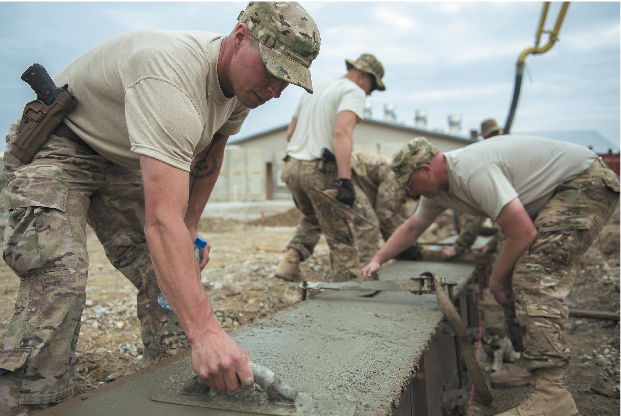
In January, the number of US military personnel inside Afghanistan decreased to about 8,500 focused on both Operation Resolute Support, the continuing commitment to training, advising, and assisting the Afghan forces, and Operation Freedom’s Sentinel, the military mission to target the Taliban, al Qaeda, and now ISIS in the country. The majority of these forces are at Bagram, home of the Air Force’s 455th Air Expeditionary Wing. US, NATO, and Afghan aircraft line the two, 9,800-plus foot long airstrips and 32 acres of ramp space.
The wing includes about 2,000 airmen, flying and maintaining dozens of aircraft that make their way through the fight in Afghanistan.
That number has dropped in recent years, however. Bagram houses only one dedicated fighter squadron for the operations. In January, that unit was the 79th Expeditionary Fighter Squadron deployed from Shaw AFB, S.C. The F-16s of the 79th stay on call, able to fly anywhere in the country within one hour to conduct close air support.
“Even though there is only one person in the airplane, we always fly as a team,” Major Joseph, the squadron’s director of operations, said in a news release. (The Air Force doesn’t provide the last names of deployed combat pilots.) This gives the pilot “access to countless resources.”
These combat aircraft have been increasingly busy in Afghanistan, as fights against the Taliban and ISIS have increased.
In February, US aircraft dropped 200 bombs in Afghanistan. This is the highest since October 2016—and the second highest since September 2014. This uptick came after the Obama administration in 2015 gave US forces increased authority to go after ISIS, and USAF took on that mission without boosting the number of deployed aircraft.
The combat effort has continued from Bagram even as the amount of tanker support at the base has dropped. As of early 2017, the Air Force no longer deploys tankers to the base full time and instead flies support missions from outside the country, said Maj. Gen. Jay B. Silveria, deputy commander of US Air Forces Central Command.
The Air Force keeps rescue aircraft, including HH-60G Pave Hawks, and aircrews deployed to Bagram on alert for personnel recovery missions. A flow of mobility aircraft and intelligence, surveillance, and reconnaissance aircraft rotate through Bagram’s massive apron.
The Air Force’s longest deployed unit in Afghanistan passed 15 years in country in January. The 41st Electronic Combat Squadron and the 755th Aircraft Maintenance Squadron of Davis-Monthan AFB, Ariz., have been continuously deployed with their EC-130H Compass Call aircraft since Operation Enduring Freedom began and have been at Bagram since 2004. The Compass Call disrupts enemy command and control by “jamming” electronics. The 41st has flown more than 39,000 hours during 6,800 combat sorties in Afghanistan.
The renewed threat from the Taliban means that as of March, some 15-and-a-half years since combat began, “we are at a stalemate,” US Central Command chief Army Gen. Joseph L. Votel told lawmakers in late March. “But stalemates have a tendency to decline over time.”
NATO as of early 2017 has a 13,000-member force deployed as part of the International Security Assistance Force for the Resolute Support mission, with its hub at Bagram. The number in Afghanistan peaked at 130,000 in 2011. Those at Bagram not focused on counterterrorism work with the Afghan force to build its capability, and for the US Air Force that involves helping to stand up and assist in the operation of Afghanistan’s small but busy fleet.
The Afghan air force has 12 A-29 Super Tucanos, four delivered early this year. The pilots and maintainers are trained in the US at Moody AFB, Ga., and have recently been flying more combat operations. The Afghan air force also flies US-made MD-530 attack helicopters, C-130 cargo aircraft, and Mi-17 cargo helicopters, among others. All need US support and training to maintain combat capability. While the Afghan forces have a limited training pipeline and have struggled to identify enough candidates, they have been effective in combat.
As of summer 2016, the Super Tucanos have flown two to four combat missions every week. They are “rapidly gaining capability” with help from US trainers and advisors, US Army Gen. John W. Nicholson Jr., commander of the Resolute Support mission, said in a December press briefing.
“It’s important to remember that five years ago, when we started building the Afghan security forces, we had about 140,000 US and coalition troops in the country,” Nicholson said. “We are now down to less than one-tenth of that. Today it’s the Afghan security forces who are responsible for securing their own country, with the assistance of our advisory and [counterterrorism] effort.”
The US military’s footprint inside Afghanistan has dwindled from its peak during the almost 16-year war, but for the thousands of troops that remain inside the walls of Bagram Airfield, Afghanistan is their temporary home and the misson endures.